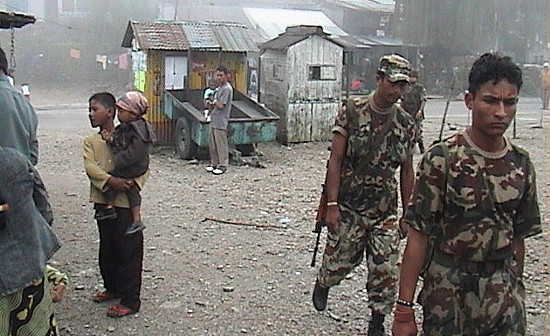Following the verification process of the Peace Accords in Nepal in December 2007 there were 19,602 ex-combatants of the Maoist People’s Liberation Army (PLA) living in the main seven cantonments (military quarters) and 21 sub-cantonments of the country. Of these, around 4000 were disqualified for being under-age when recruited in May 2006 at the last cease-fire. The United Nations Mission in Nepal (UNMIN) has since categorised these people as ‘Verified Minor and Late Recruit’ (VMLR) and recommended that the Maoist party and the government remove them from the cantonments. This verification process was carried out by the United Nations Mission in Nepal (UNMIN) in December 2006 under the three-way agreement between the Government of Nepal, the United Nations and the Maoist party. (UNMIN ceased operations in Nepal in January 2011.)
Dilemmas for those excluded from the reintegration process
Vocational skills training, micro-enterprise development, health-related training and education, and formal and non-formal education have been provided to the VMLRs under the UN Interagency Rehabilitation Program (UNIRP), with several other UN and international agencies involved in a rehabilitation programme which has created opportunities for 2,149 VMLRs.
Slowly and gradually these VMLR ex-combatants are being accepted back into the society. They are making their livelihoods and regaining a normal life. However, the majority of the VMLRs have not been satisfied by the categorisation process which has disqualified them from being tagged as ex-combatants.
The dissatisfaction of the VMLRs was further increased when a decision was taken to pay a package amount of up to 800,000 Nepalese rupees (around $10,000) to the ex-combatants who opted for the retirement scheme. (There are three schemes offered to the ex-combatants to choose from: those wanting to reintegrate into the security agency; those wanting voluntary retirement; and those who want rehabilitation). But the VMLRs were not included in this scheme. They are not pleased at being disqualified and not treated the same as the other ex-combatants who remain in the cantonments.
Indeed, the Maoists party has an unofficial policy of not allowing any civil society organisations to engage and work for the rehabilitation and reintegration processes of the ex-combatants. However, some of the organisations, in association with UNICEF, have managed to engage in rehabilitation and reintegration work with the VMLRs. Human Rights Education and Peace Action Group (PAG) have also engaged with skills development training, formal and non-formal education and health-related training for the VMLRs in eastern Nepal.
Dilemmas for those awaiting reintegration
The reintegration of the Maoist ex-combatants into the security forces was seen as one of the key components of Nepal’s Peace Process. However, instead of a process managed along international principles and practices (and adapted to local context), almost all the political parties - including the Maoists party itself - have been playing with the ex-combatants' fates. As a result, around 16,000 Maoist ex-combatants remain in the cantonments.
Nevertheless, the special committee responsible for the management, rehabilitation and reintegration of the Maoist ex-combatants, and headed by the Prime Minister, has now reached an agreement to begin the process of categorisation of the ex-combatants. This process was started by the technical committee working under the special committee from November 2011. The three categories included are:
- those who wants to reintegrate into the security agency, mainly into the Nepal Army;
- those who want to retire voluntarily; and
- those who wants to be rehabilitated.
He further stated, that his party had its own economic policy and that the voluntarily-retiring combatants must now pay 40% of the package portion to the party. Even though the NC and CPN-UML are members of both the special and the technical committees, and so therefore also responsible for the management, rehabilitation and reintegration of the Maoists ex-combatants, the Chief of the Maoists combatants entirely ignored the concerns of these parties.
Following this, chain of command for the ex-combatants was handed over to the Nepal Army, by decision of the cabinet and the three major political parties: Unified Communist Party of Nepal-Maoist (UCPN-M); the NC; and the CPN-UML and its special committee. Control of the all weapons of the Maoists party stored in the different cantonments was also taken by the Nepal Army.
But the revolutionary faction of the Maoist party, lead by the Mohan Baidhya aka Kiran, was completely dissatisfied with the decision to handover the chain of command and weapons of the ex-combatants to the Nepal Army. Kiran claimed that handing over control of the People’s Liberation Army (PLA) and the weapons was like the dissolution of the PLA and surrender to the reactionary forces they had fought against.
There was also major debate over whether the same requirements for ordinary recruits to the Nepal Army should also be applied to the ex-combatants.
Leaders of the Maoist party and the chief of the combatants are argue they should not, but the major question remains unanswered: will they integrate or recruit into the Nepal Army?
The ex-combatants have been strongly demanding a dignified reintegration of the ex-combatants, and the Maoist leaders have claimed they would rather send their ex-combatants into voluntary retirement if there are no guarantees of a dignified integration. However nobody is clear about what a ‘dignified’ integration means, and what criteria should be applied.
The lack of a clear vision by the Maoist leadership means that the ex-combatants face upheaval even after resettlement in the cantonments. Nepal still lacks the political will and stable government – after the recent dissolution of the Constituent Assembly - necessary to create a roadmap for reintegrating the combatants. As such, their future remains uncertain, representing a major stumbling block for Nepal’s peace process.










